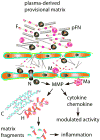The extracellular matrix as a modulator of the inflammatory and reparative response following myocardial infarction
- PMID: 19631653
- PMCID: PMC2824059
- DOI: 10.1016/j.yjmcc.2009.07.015
The extracellular matrix as a modulator of the inflammatory and reparative response following myocardial infarction
Abstract
The dynamic alterations in the cardiac extracellular matrix following myocardial infarction not only determine the mechanical properties of the infarcted heart, but also directly modulate the inflammatory and reparative response. During the inflammatory phase of healing, rapid activation of Matrix Metalloproteinases (MMP) causes degradation of the cardiac extracellular matrix. Matrix fragments exert potent pro-inflammatory actions, while MMPs process cytokines and chemokines altering their biological activity. In addition, vascular hyperpermeability results in extravasation of fibronectin and fibrinogen leading to formation of a plasma-derived provisional matrix that serves as a scaffold for leukocyte infiltration. Clearance of the infarct from dead cells and matrix debris is essential for resolution of inflammation and marks the transition to the proliferative phase. The fibrin-based provisional matrix is lysed and cellular fibronectin is secreted. ED-A fibronectin, mechanical tension and Transforming Growth Factor (TGF)-beta are essential for modulation of fibroblasts into myofibroblasts, the main collagen-secreting cells in the wound. The matricellular proteins thrombospondin-1 and -2, osteopontin, tenascin-C, periostin, and secreted protein acidic and rich in cysteine (SPARC) are induced in the infarct regulating cellular interactions and promoting matrix organization. As the infarct matures, matrix cross-linking results in formation of a dense collagen-based scar. At this stage, shielding of fibroblasts from external mechanical tension by the mature matrix network may promote deactivation and cellular quiescence. The components of the extracellular matrix do not passively follow the pathologic alterations of the infarcted heart but critically modulate inflammatory and reparative pathways by transducing signals that affect cell survival, phenotype and gene expression.
2009 Elsevier Ltd. All rights reserved.
Figures




References
-
- Senzaki H, Paolocci N, Gluzband YA, Lindsey ML, Janicki JS, Crow MT, et al. beta-blockade prevents sustained metalloproteinase activation and diastolic stiffening induced by angiotensin II combined with evolving cardiac dysfunction. Circ Res. 2000;86:807–15. - PubMed
-
- Opie LH, Commerford PJ, Gersh BJ, Pfeffer MA. Controversies in ventricular remodelling. Lancet. 2006;367:356–67. - PubMed
-
- Siwik DA, Chang DL, Colucci WS. Interleukin-1beta and tumor necrosis factor-alpha decrease collagen synthesis and increase matrix metalloproteinase activity in cardiac fibroblasts in vitro. Circ Res. 2000;86:1259–65. - PubMed
Publication types
MeSH terms
Substances
Grants and funding
LinkOut - more resources
Full Text Sources
Other Literature Sources
Medical
Research Materials
Miscellaneous

